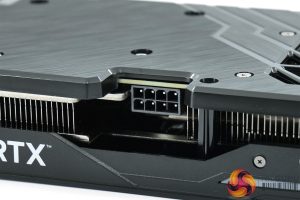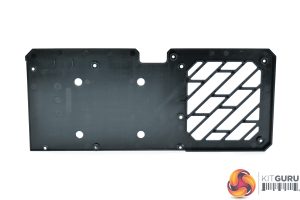Palit's RTX 4070 Dual ships in a black box, with some blue accents on the front – you can also make out the two fans, hence the name ‘Dual'. On the back, Palit highlights some key information in multi-lingual text.
Interestingly, there were no included quick-start guides or any accessories in the box, possibly due to my sample being a pre-release review unit, but a quick-start guide for a new user wouldn't have gone amiss.
Looking at the card itself, Palit has also opted for a minimalist design, with an all-black plastic shroud. The build quality isn't going to blow you away as there's a bit of flex to the plastic used, but it's not the end of the world – once installed, how often are you going to touch the card anyway?
As we mentioned, the name ‘Dual' refers to the dual fan layout, with Palit opting for two 100mm fans here.
In terms of the size of the card, we again don't have official dimensions at the time of publishing, but I measured the card at approximately 267 x 130 x 40mm, so it's a standard dual-slot thickness.
The front side of the card is home to the GeForce RTX and Palit logos. The small grey strip underneath the Palit logo is actually an RGB strip – it's very basic, with just three effects to choose from within Palit's Thundermaster software, but I suppose it's better than nothing.
As for the backplate, I am a bit disappointed Palit has opted for a plastic backplate here, it definitely adds to the less-than-premium feel that was started with the plastic shroud. I get this is a ‘MSRP' card, but it's still nearly £600 – Gigabyte managed it, I would have expected the same from Palit.
As mentioned on the previous page, Nvidia is now allowing its partners to ship 4070s with a single 8-pin power connector if they wish – considering the TGP of the GPU is only 200W, this is no problem at all from a power perspective and means users don't need any adapters or new cables. Display outputs consist of 3x DisplayPort 1.4 and 1x HDMI 2.1.
Disassembling the card to look at the PCB, Palit has opted for a less beefy 6+2 VRM, so one fewer GPU phase than Gigabyte. Palit is using OnSemi's NCP302150 MOSFETs, rated at 50A. As per the Gigabyte Windforce, a UPI UP9512R controller is used for the GPU VRM, with a UPI UP9529Q looking after the memory VRM.
As for the cooler, Palit has opted for four 6mm heatpipes, with the GPU and VRAM contacting a unified baseplate. A separate fin array is used to contact the VRM MOSFETs.
Palit is using a plastic backplate, purely for aesthetic reasons – it will not help dissipate heat from the back of the PCB.
 KitGuru KitGuru.net – Tech News | Hardware News | Hardware Reviews | IOS | Mobile | Gaming | Graphics Cards
KitGuru KitGuru.net – Tech News | Hardware News | Hardware Reviews | IOS | Mobile | Gaming | Graphics Cards
















